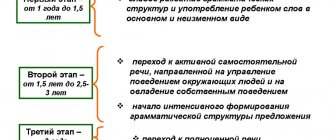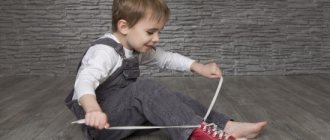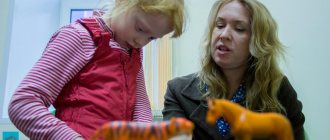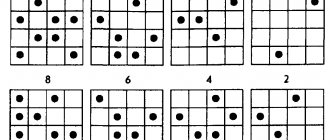Children master their native speech gradually. Each age has its own norm. It is useful for mothers and fathers to know the levels of speech development of children by age, so as not to miss the possible lag of their child. But do not forget about the individual pace of development. Age standards are a very relative concept.
In the article we will talk about the development of speech by age, correct verbal communication with the baby.
Stages of speech development by age
The development of speech is reflected in the table - it occurs in several stages:
| Dorecheva - from birth to 12 months | - by 2 months the baby begins to walk and babble - by 7 months. pseudowords appear - by 8 months - the first babbling words, by a year up to 30 such words Closer to one year, the baby gradually learns intonation, melody, and rhythm of conversation. Fulfills requests |
| Pre-grammatical - stage of primary speech development (from one to 2 years) | — the dictionary is replenished with new words - by 2 years old knows 250 - 300 words - everyday speech appears |
| Grammar acquisition stage (third year of life) | - they speak, but cannot yet formulate phrases grammatically - express their thoughts and desires - sentences from one word, and later from 3-4 words - function words appear - understand the stories of adults about phenomena and events in which they did not personally participate - speech gradually becomes more coherent |
| From 3 to 4 years | — children’s vocabulary is actively expanding (up to 2 thousand words) - a sense of language is formed - extended speech - can make rhymes, learn poetry |
| From 4 to 5 years | - with normal speech development, five-year-olds already speak coherently and competently - know up to 4000 words - can make up a story based on a picture - know the classification of objects |
| From 5 to 6 years | - know up to 5000 words - use all parts of speech - can compose a complex story based on a picture, change the plot |
Levels of speech development in children by age
At each period, the baby must master certain skills.
From birth to 12 months
In the period from birth to the end of infancy, speech development by age (month) occurs in this way.
Immediately after birth, the newborn makes its first sound - a cry. During the first month of his life, he learns to respond to someone addressing him - depending on the intonation, he cries or smiles.
From about 2 months. the baby begins to roar. At the same time, he listens to his own sounds. Moreover, all over the world children walk the same way!
From 3 months, babies begin to babble. This is the beginning of mastering the phonetics of the native language.
At 5 months, babies take a closer look at the articulation of adults and try to copy it. A six-month-old baby can say individual syllables for the first time (for example, “ma-ma”) and begins to associate objects with sounds (“meow” - “cat”). That's when you need to start talking to him a lot.
At 7 – 8 months. Babies constantly babble, and understand the meaning of individual words. Semantic pauses appear: the baby “says” something and falls silent - waiting for the adult’s answer. These are his first attempts to communicate with people - answer your child!
At 9–10 months, with normal speech development, the first words may appear. Now “mom” is not just a syllable, but a meaningful word. The babbling becomes more complex. Children listen to what adults say. The passive vocabulary is expanding. It is necessary to create favorable conditions for the baby to develop a vocabulary.
By 12 months, the baby speaks from 2 to 10 words, can pronounce “a”, “u”, “i”, “m”, “b”, “p”.
Stage of development of active speech - from 1 to 2 years
The baby likes to repeat words and syllables after his parents. He's doing it wrong so far: he uses one word to mean several things at once. For example, “bibi” is any type of transport and movement. He actively uses gestures and facial expressions.
By the age of 1.5 years, the passive vocabulary is supplemented by 100 words, they begin to speak in simple sentences of two words (for example, “Uncle Bibi” (this can mean a man in a car and the action - a man drives a car). These are signs of the emergence of phrases.
Two-year-olds can pronounce more sounds: “f”, “x”, “v”, “d”, “k”, “o”, “n”, “t”, and three-year-olds - “l”, “s”, “ Hey".
Preschool period - from 3 to 6 years
Includes junior (3 – 4 years), middle (4 – 5), senior (6 – 7) preschool age. Let's consider age-related norms for speech development in preschoolers.
Three-year-old children have about 3,000 words in their vocabulary, and it is constantly growing. Almost all younger preschoolers pronounce sounds incorrectly, which may be a reason to contact a speech therapist. Their conversation is interesting: they make up new words.
At 3–4 years of age, speech development, according to the table, is characterized by excellent pronunciation of “ts”, “y”, “z”, at 5 years - “zh”, “sch”, “r”, “ch”, “sh”. But many replace hissing ones with whistling ones (“puppy” - “senochka”).
Four-year-old children are “why kids”. They constantly ask questions, the task of adults is to answer them. It is then that the sense of language is formed. Kids can replace or omit syllables, use endings, prefixes, suffixes incorrectly, do not agree words in sentences, place stress incorrectly - this is all normal, because their grammatical structure is just being formed. But phrases are being improved: adjectives appear.
With normal speech development, a five-year-old preschooler can retell a fairy tale or come up with a story based on a picture. The story becomes more varied and correct. Hissing sounds are good, and some guys are good at “r”, but more often it’s isolated. They feel intonation and can change the strength and pitch of their voice down to a whisper. The dictionary is rapidly expanding with new words that are easy to remember.
As can be seen from the table of speech development, older preschoolers are at an even higher level. Six- to seven-year-old children clearly pronounce sounds and can identify them in words. This is important when preparing for school. But the vocabulary of all six-year-olds is different: for some it is very rich, while for others it is limited to everyday topics. The grammatical structure of speech is formed, although verbs may be conjugated incorrectly (saying “are going” instead of “going”). But they make mistakes where many adults make them.
The children have coherent, logical speech, they answer with detailed, complex phrases, make up stories based on pictures, retell stories, share impressions about films, and fantasize.
Structure of the hearing organ
Sounds surround a person from birth. There are 3 sections of the hearing organ:
- outer ear;
- middle ear;
- inner ear.
The outer ear is the visible part of the organ. It is represented by the auricle and the external auditory canal. The concha is a funnel-shaped cartilage covered with skin. On its surface there are various formations: pits, curls, hills. They help improve sound quality, make it louder and direct it into the ear canal.
The fibers of the ear muscles are attached to the concha. In the process of evolution, man has lost the ability to “move his ears” in order to more accurately localize sounds; these muscles work in rare “lucky” people. The skin of the shell has sebaceous and sweat glands.
The external auditory canal is a winding canal, the length of which is slightly more than 2 cm, and the diameter is up to 0.7 cm. In it, the sound signal continues to be amplified and transmitted to the middle ear. The passage is lined with skin containing sebaceous and sulfur glands. Earwax is a yellowish substance that provides hydration to the canal and protection against infectious agents. When accumulated and compacted, it forms plugs that disrupt the movement of the eardrum. This can lead to conductive hearing loss.
Describing the structure of the hearing organ, anatomists indicate that the outer part of the canal has cartilaginous walls, and the part in contact with the middle ear has bone walls. The structures of the middle and inner ear are located in the body of the temporal bone.
The eardrum is a thin membrane covered on the outside with skin and on the inside with mucous membrane. In young children, it has an opening that exposes the middle ear to the outside environment and is more vulnerable to infection. It closes by 3 years.
The middle ear is a cavity whose volume is slightly more than 1 cubic centimeter. It contains three small auditory ossicles, which are connected to each other in a chain:
- hammer;
- anvil;
- stapes.
They are named so because of their resemblance to everyday objects. The stapes connects to the window of the vestibule. The middle ear is also connected to the nasopharynx via the Eustachian tube.
The inner ear is the most bizarre formation of the human hearing organ. It consists of:
- vestibule (vestibulum);
- snails;
- semicircular canals.
The organ of hearing includes only the cochlea. It contains lymphatic fluid and stretches fibers (the main membrane). Each of the fibers is like a small string and “responds” (resonates) to a sound of a certain frequency. There are about 25 thousand of these fibers. On the wall of the cochlear canal there is a receptor field, which consists of nerve (hair) cells - the organ of Corti. The death of hair cells can lead to sensorineural hearing loss.
Parenting mistakes and how to avoid them
Mothers, fathers, grandmothers, grandfathers make some mistakes when communicating with their children. Subsequently, they can inhibit the development of the child’s speech or form incorrect perceptions and complicate the process of mastering their native language.
These are the errors:
- Assume that the child does not understand anything. Even during the infant period, a passive vocabulary is formed, they learn to respond to appeals to them. Otherwise, how does a child who has not communicated with anyone except relatives suddenly “give out” swear words, for example? Did you say that in front of the baby? Do not be surprised;
- Imitate “childish” speech. Babysitting and diminutive forms of words only complicate their perception and interfere with the normal development of speech. It’s easier for a baby to remember and then say the word “ball” than “ball.” But you shouldn’t simplify the words either. If you want your child to start speaking correctly, speak to him correctly from the very beginning;
- Talk a lot. For normal speech development, it is important to talk to your baby. But do not use florid phrases or complex words. Speak in simple sentences with babies 1–3 years old. When communicating, take into account the level of speech development of children by age;
- Don't talk at all. Children with communication deficits are often diagnosed with speech and mental disorders in early childhood;
- Don't explain. Explain the meaning of words. Even better, demonstrate it clearly. Say, “an apple is a fruit” and show a real apple or a picture. From the first months of life, carry your child in your arms and show him everything he sees around him: household objects, trees, cars, cats, dogs, birds on the street - and name them. This is what develops your child best;
- Speak slurred, quickly. When talking to your daughter or son, be sure to turn your face to him so that he can see your lips. Speak clearly, articulately, focusing on articulation, do not “crumple” words - otherwise your child simply will not understand where sounds come from and how to pronounce them. Work on your diction and conversation rate.
The best way to communicate with your baby is as with an adult. In a calm voice, but with a friendly and affectionate intonation. It is this kind of treatment from mom and dad that contributes to the formation of correct speech in their son or daughter.
Advice from speech therapists to parents
We have given some recommendations above. But there are a few more.
First, check whether your child is at risk for delayed speech development. These are children who have perinatal lesions of the central nervous system and other neurological problems, birth injuries, frequent illnesses in the first year of life, post-vaccination complications - against the background of such problems, speech may develop more slowly.
Secondly, pay attention to when the child first began to walk and said the first syllables and words. If much later than the established norm, consult a speech therapist or neurologist.
Thirdly, when the baby turns 2 - 2.5 years old, show him to a speech therapist. Especially if he is at risk. This will allow you to timely identify possible problem areas in speech development and eliminate them.
Functions of the hearing organ
When talking about the functions of the hearing organ, physiologists describe them in accordance with their anatomical structures. So, each department has its own specific tasks:
- catches sounds and directs them further (outer ear);
- transmits sound waves (outer and middle ear);
- protects against infections, loud sounds, damage to internal parts (outer ear, eardrum);
- transforms sound energy into electrical energy (inner ear).
The functions of hearing are evolutionarily closely related to danger notification and communication in the community. In order to maintain your ability to hear for a long time, you must follow simple rules for preventing hearing loss.
Features of the hearing organ
Human hearing organs are paired. What does this mean? A person can listen with both the right and left ear at the same time. Binaural hearing gives more information about the sound and amplifies it under certain conditions.
If the source of mechanical vibrations is at the same distance from the right and left ears, the signal volume increases by 50%. This means that in case of unilateral impairment, compensation with the help of a hearing aid of even low power significantly improves the quality of life.
Perceiving with two ears is better for determining the localization of sound. Binaural hearing gives:
- surround sound sensation;
- idea of the location of the source.
This helps you avoid danger (such as an approaching car) and isolate useful sounds from all the background noise when talking to one person in a noisy room.
Read more about hearing characteristics in this article.
If you experience any hearing problems, you must urgently undergo a hearing test using professional equipment. If you seek help in time, you have a chance to fully restore your hearing.
What are the dangers of speech disorders in children?
Speech activity in children is directly related to the development of the psyche and affects the intellectual, sensory, emotional and volitional spheres of life. If it is impossible to communicate normally with peers, a child may develop serious psychological complexes, even a phobia of communication. Such children are characterized by depression, depression, low motivation, frequent changes of interests, uncertainty, irritability, resentment, aggression, and problems with self-control.
Children with speech disorders are also noted to have impaired physical development: lack of coordination of movements, retardation in actions, and general weakening of the body.
Ignoring speech disorders in children is fraught with their complete social isolation.









